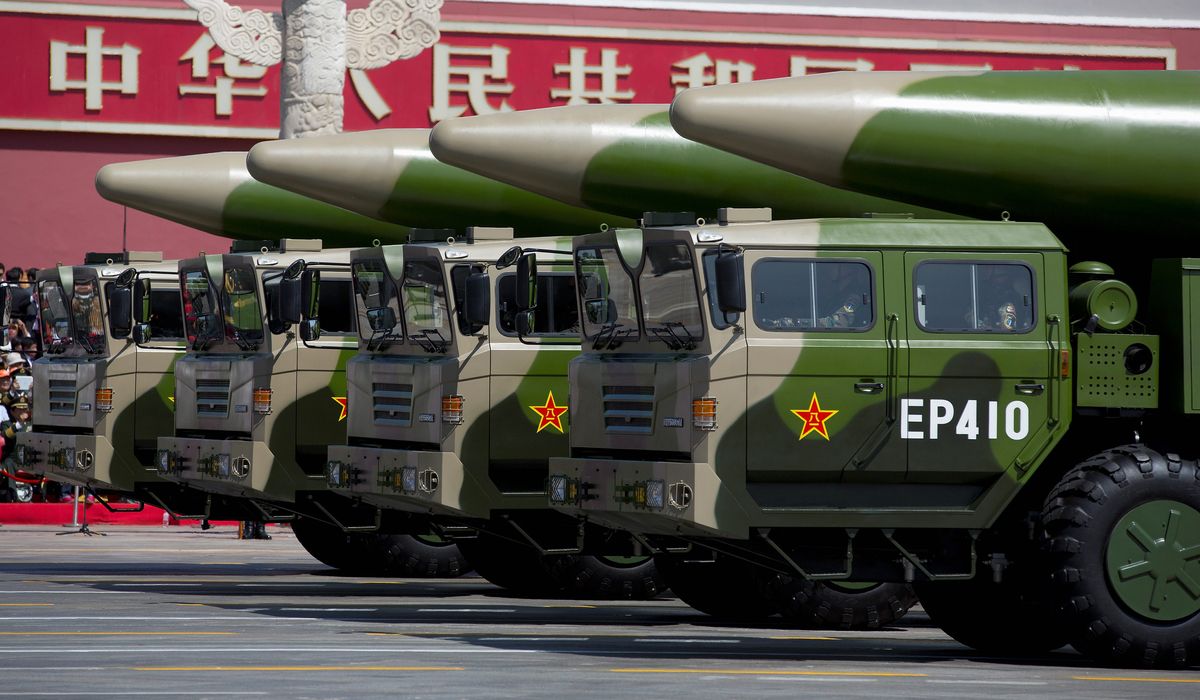
Pentagon officials are keenly aware of the dangers posed by China‘s cutting-edge weapons and its rapidly expanding military prowess across a host of domains.
But perhaps of even greater concern are capabilities Beijing has kept partially hidden from the rest of the world, raising questions about whether the U.S. and its allies truly have a grasp on what tools the People’s Liberation Army (PLA) has at its disposal.
Top military officials told The Washington Times this month that no nation in history has consistently stayed ahead of U.S. estimates as well as China has done recently. Even the Soviet Union, during the height of the Cold War, did not surprise American intelligence and Pentagon analysts in quite the same way, military officials said, fueling fears that Beijing could catch the U.S. and its allies off guard in a future conflict.
Over just the past several months, major revelations about the extent of China‘s hypersonic weapons capabilities, its nuclear arms stockpile and even the size of its navy have sparked concerns that Washington may not have a full window into exactly what its 21st-century rival has up its sleeve or what may be under development deep inside the communist nation.
China also has poured tremendous amounts of money and manpower into its cyberwarfare programs, space capabilities and military drone initiatives, and it’s not entirely clear whether U.S. projections on those fronts offer a complete picture.
China‘s official military budget, at an estimated $245 billion last year, is less than a third of the total U.S. military budget and just 1.7% of gross domestic product compared with 3.7% for the U.S. But the Pentagon faces a global military mission while the People’s Liberation Army largely focuses on the Asian theater, and many doubt the official Chinese spending numbers capture the entire military budget.
Specialists say it’s vital to get as full an account as possible, as Beijing has tailored virtually all of its major military programs toward defeating the U.S. in a hypothetical battle for Taiwan or another major battle in the Pacific.
Knowing what the American military may go up against is crucial, but getting answers is exceedingly difficult at best and virtually impossible at worst.
China is in the midst of “a military modernization effort specifically focused on the ability to accomplish their political objectives with military force. … One gets the sense that the People’s Liberation Army is not messing around and they’re moving out with a great sense of urgency,” said Bradley Bowman, senior director of the Center on Military and Political Power at the Foundation for Defense of Democracies, a leading Washington think tank. “They have methodically gone after leading technologies around the world and licitly and illicitly acquired those technologies to build this world-class military designed to defeat ours.”
While recent Pentagon assessments have offered an unprecedented level of detail about Chinese military capabilities, Mr. Bowman said it should come as no shock that Beijing is able to keep some of its programs under wraps.
“We have a hard time figuring out what’s going on in Afghanistan. Try penetrating China. … This is a hard task,” he said. “You put all of that together, and I’m not surprised that we’re surprised.”
‘China is getting a lead’
Indeed, top Pentagon leaders conceded that the U.S. was caught somewhat off guard by China‘s test this summer of a nuclear-capable hypersonic missile that circled the globe. Defense officials have long warned that Beijing‘s hypersonics weapons program was at the cutting edge and in some ways ahead of America’s, but that specific test showed an unexpected capability that set off alarm bells in national security circles.
Just last week, a major Defense Department report on China revealed that the U.S. now expects China to have 1,000 deliverable nuclear warheads by 2030 — blowing past Defense Department projections offered as recently as last year. That report also found that China now boasts the world’s largest navy, at 355 ships and submarines.
Officials believe that trend will continue, with China consistently at the outer limits of U.S. military power projections.
“One of the most interesting things about being a China-watcher over maybe the last 10, 15 years has been it’s the only country certainly in my memory, and I’ve had people in the intelligence community tell me that they’ve never seen a country that consistently accelerates faster than we estimate,” said Lt. Gen. S. Clinton Hinote, the Air Force’s deputy chief of staff for strategy, integration and requirements.
“The Soviets didn’t do that. Certainly not North Korea or Iran, anything like that,” Gen. Hinote told The Times in an interview last week. “But China has done a good job of taking their economic power … and applying that to acceleration of military capability. And this is why you’re seeing things like the hypersonic test” conducted by China last summer and recently confirmed by top Pentagon officials.
“I always expect China is going to be pushing the edge of that envelope increasingly forward,” he said, adding that the hypersonic test and the way in which it was conducted “did catch people by surprise” inside the Pentagon.
Some credit Chinese President Xi Jinping, who also heads the country’s Central Military Commission, for introducing improvements in both hardware and organization for the People’s Liberation Army since taking power in 2013.
“Xi’s arrival heralded an acceleration of modernization and solutions to problems that had confounded his predecessors,” Joel Wuthnow, a senior research fellow in the Center for the Study of Chinese Military Affairs at the National Defense University, wrote in analysis for the East Asia Forum Quarterly last year. “While many had their origins under [predecessors Jiang Zemin and Hu Jintao], a number of key systems came online in the Xi era, including the indigenous aircraft carrier Shandong, the Type-055 guided missile destroyer, the J-20 stealth fighter, the Y-20 long-range transport aircraft, the DF-21D anti-ship ballistic missile and the DF-17 ballistic missile fitted with a hypersonic glide vehicle.”
Mr. Xi also moved the military away from a top-down Soviet military model and cracked down on corruption in the senior ranks. The result: “a military better manned, organized and equipped to implement Chinese policy domestically and in the region,” Mr. Wuthnow concluded.
The Defense Department’s recent comprehensive report on the PLA raises other concerns about potential capabilities not fully understood by the West. In space, for example, the Pentagon found that China “is employing more sophisticated satellite operations and is probably testing dual-use technologies in space that could be applied to counter-space missions.”
The country also has become a global leader in drones and is developing a host of new intercontinental ballistic missiles, defense officials said, along with “biological activities with potential dual-use applications.”
Beijing is making strides in artificial intelligence and will likely incorporate AI into a host of military capabilities, the Pentagon said, including psychological and public opinion warfare waged against the U.S. via social media campaigns and through other avenues.
“The PLA will likely continue to develop its digital influence capabilities by incorporating advancements in artificial intelligence to improve the quality and deniability of its messaging,” the Defense Department said in its China study.
On Capitol Hill, lawmakers are increasingly concerned that U.S. officials and private analysts have failed to adequately grasp the scope of the dangers posed by the Chinese military, including the PLA‘s construction of man-made islands in the Pacific that will make it far easier to launch military offensives.
“When you see what [China is] doing, not only building these man-made islands that extend their kinematic range by 500 to 800 miles, but also by testing hypersonic weapons, building missiles that go Mach 25 with a range that touches the continental United States,” Rep. Mike Garcia, California Republican and Navy veteran, told Fox Business this week.
“We are setting ourselves up for a perfect storm where the United States is probably more vulnerable against this giant bear called China than we ever have been,” he said. “China is getting a lead, and we need to take them seriously.”








